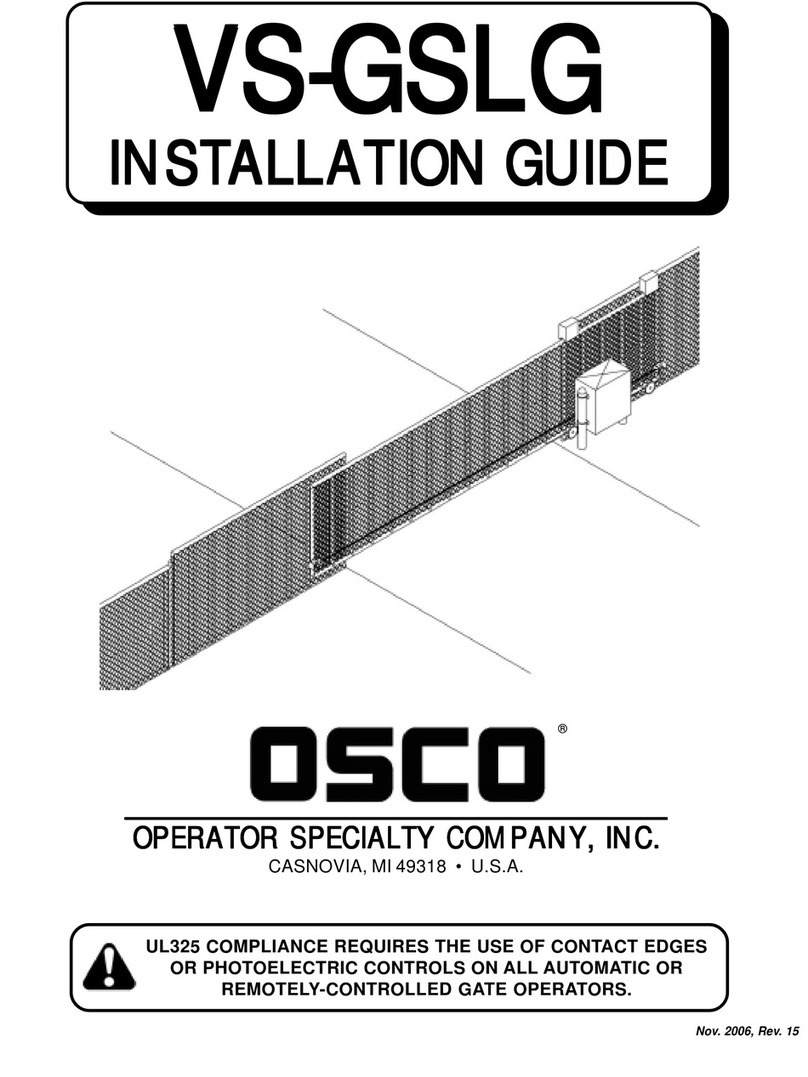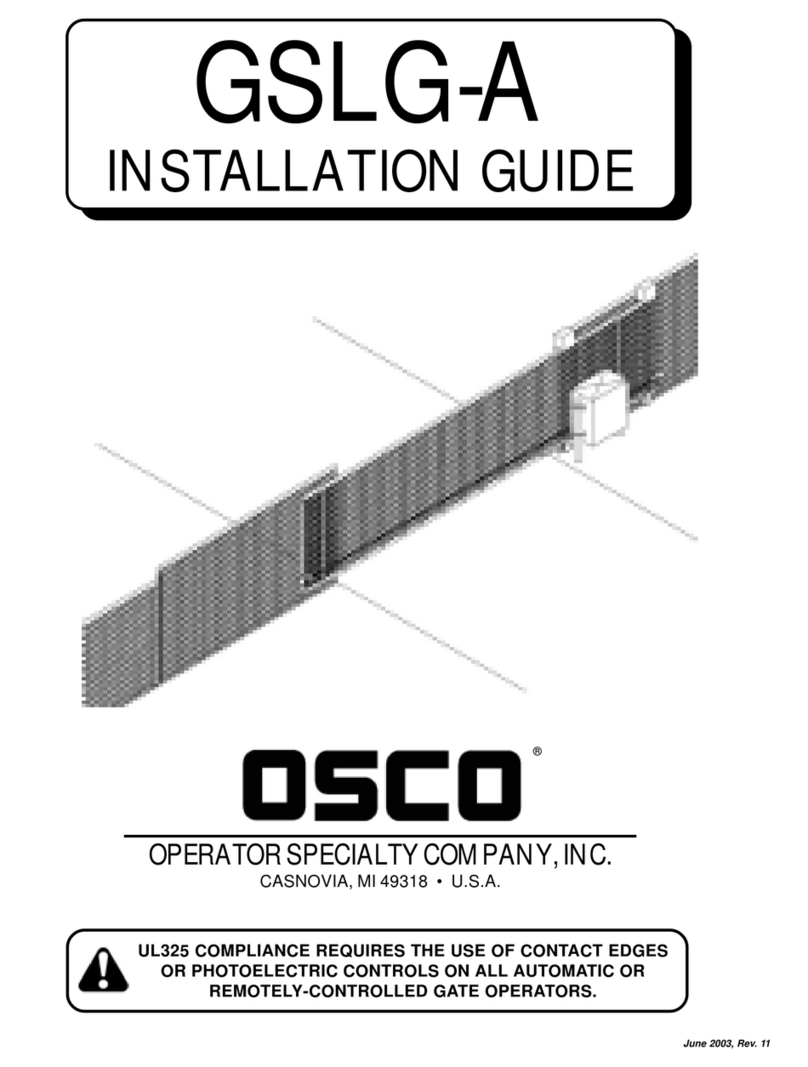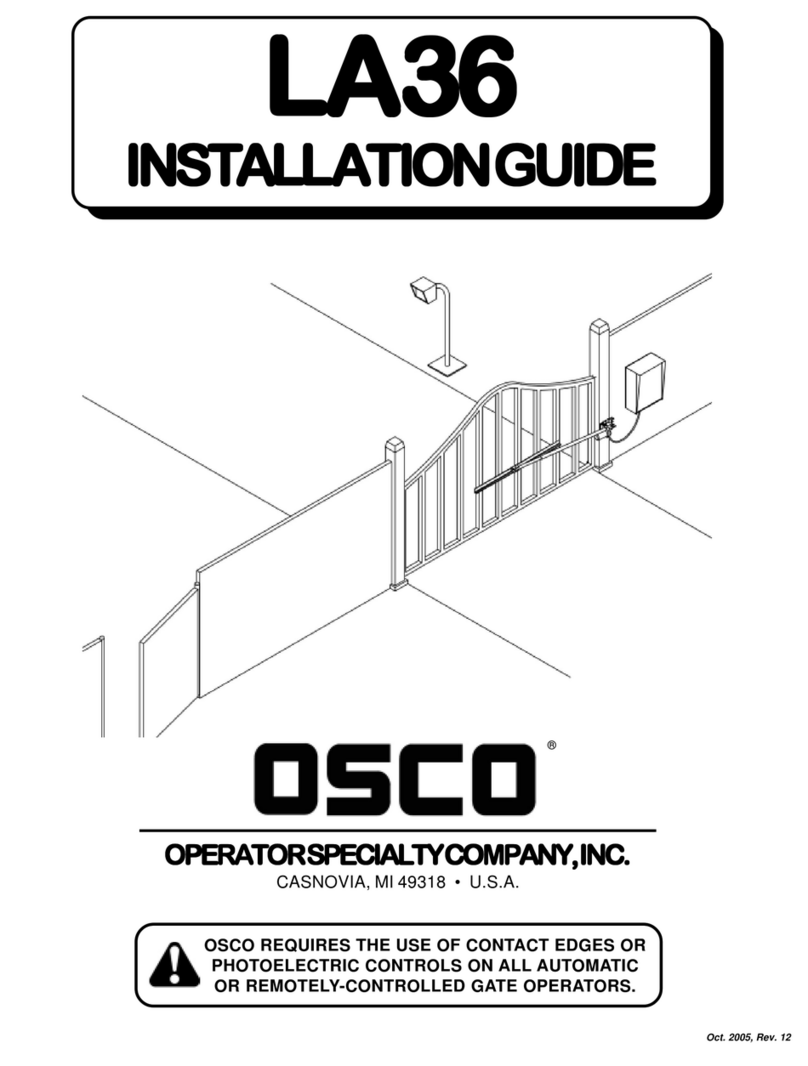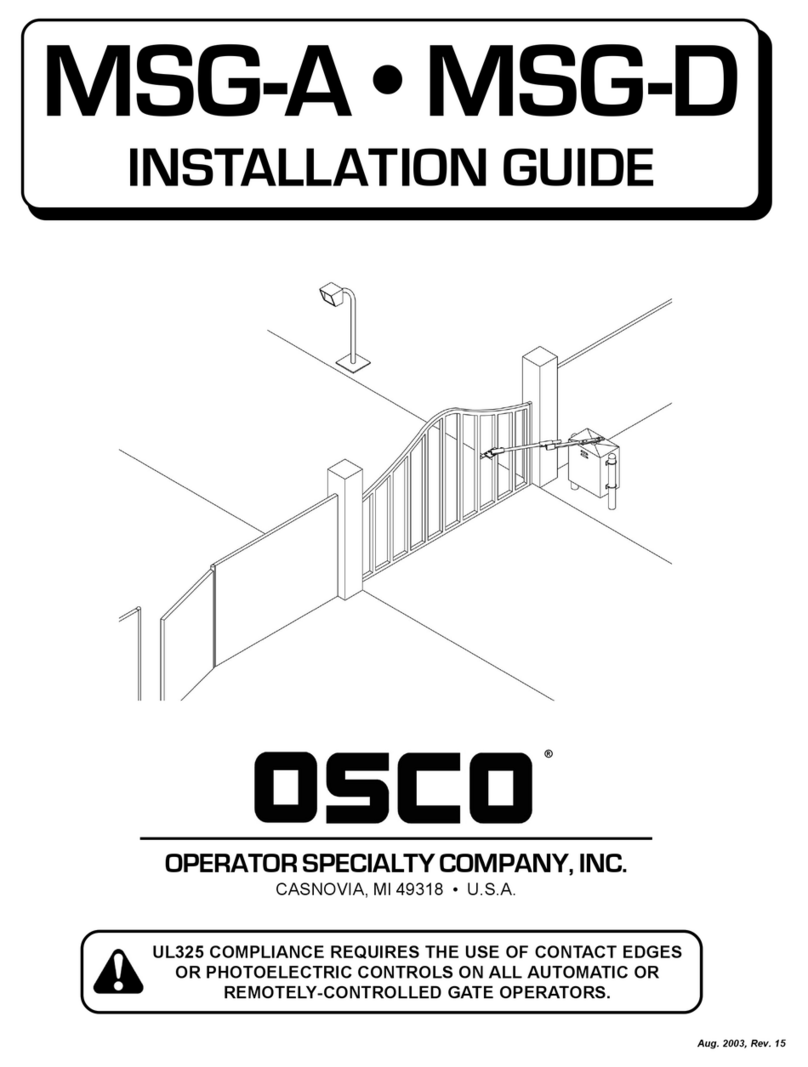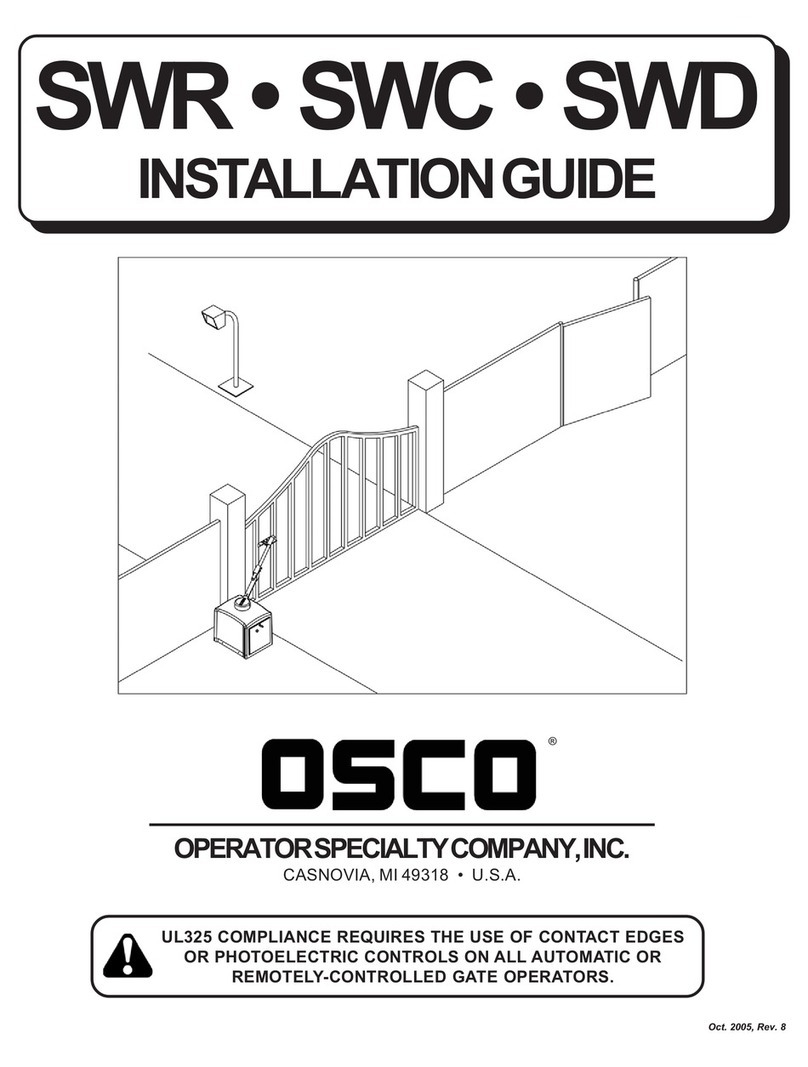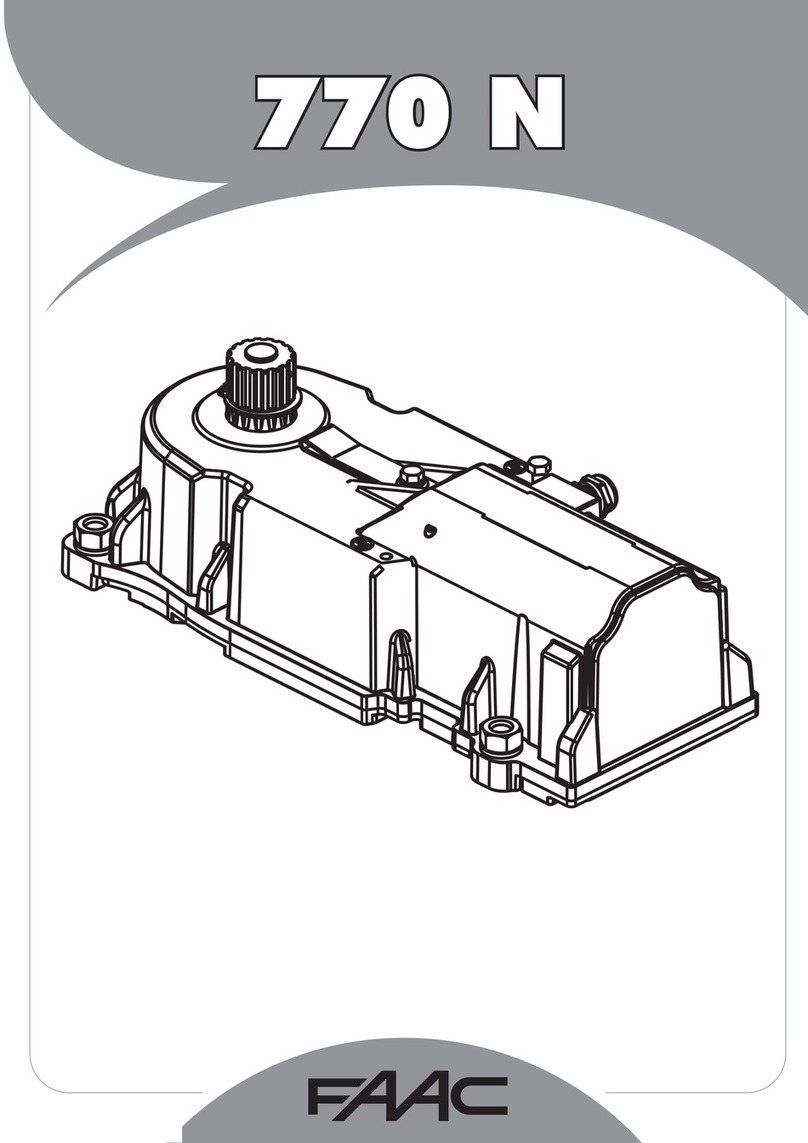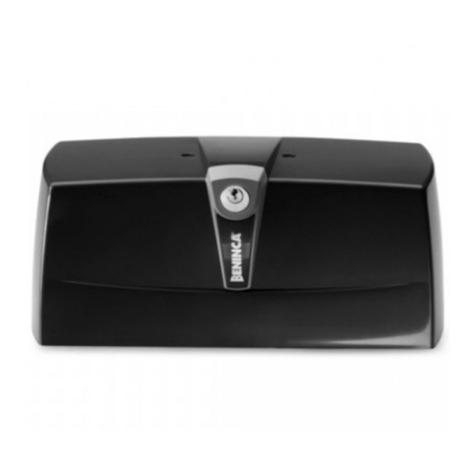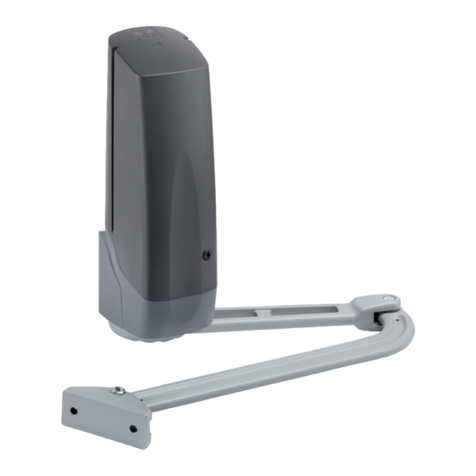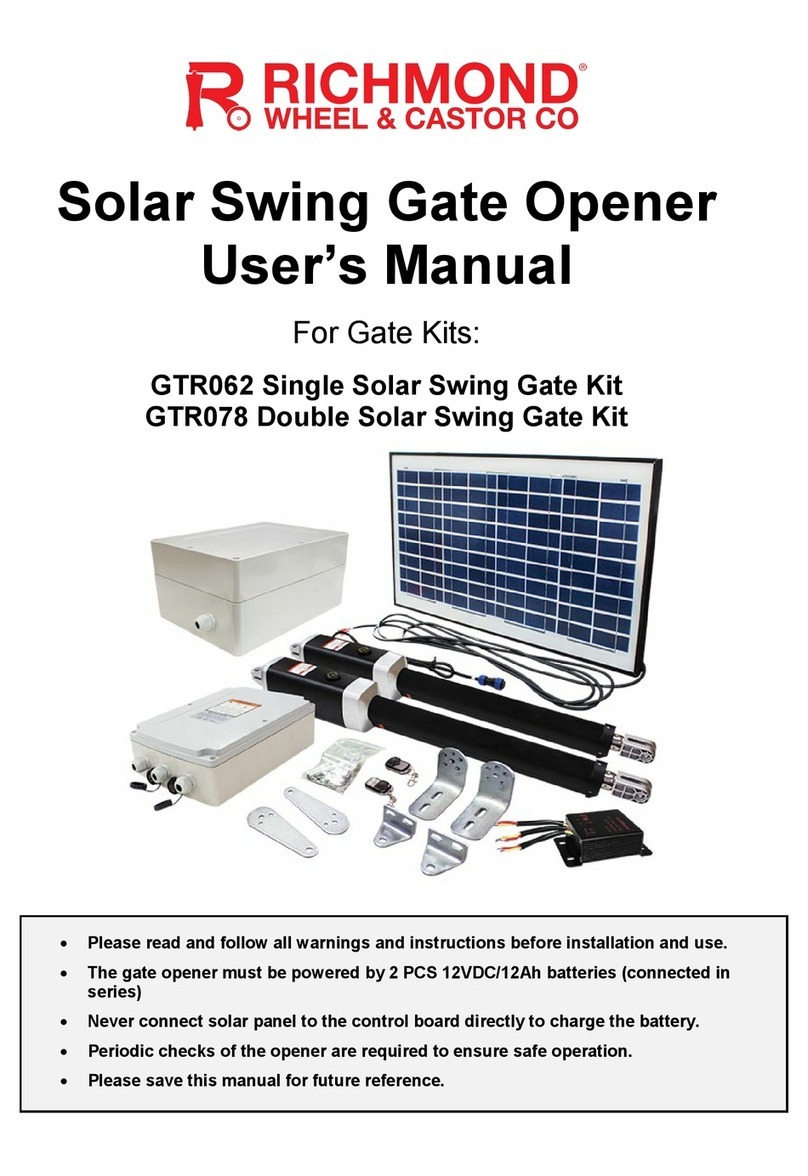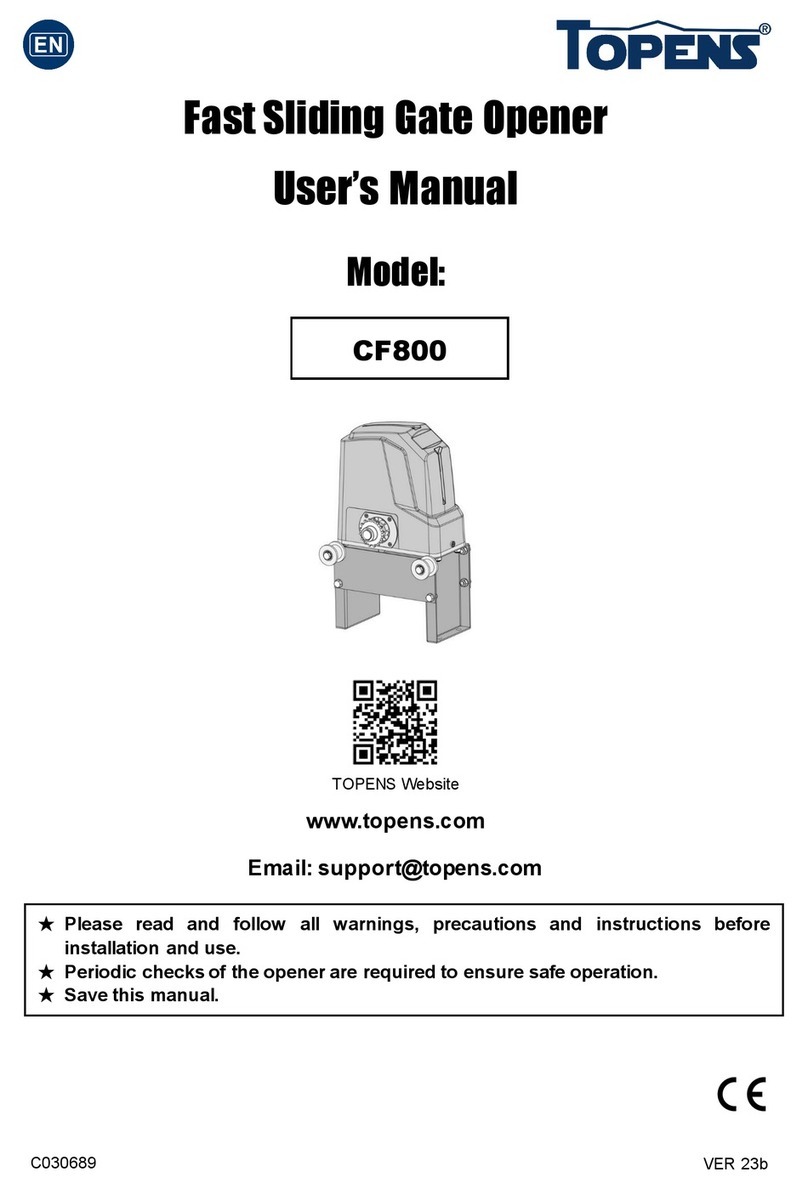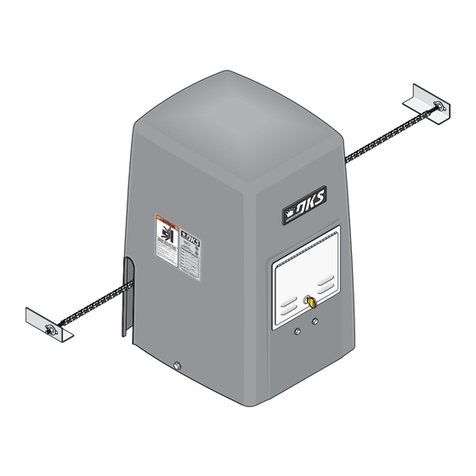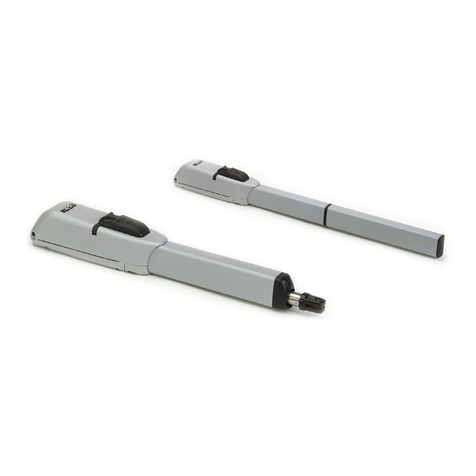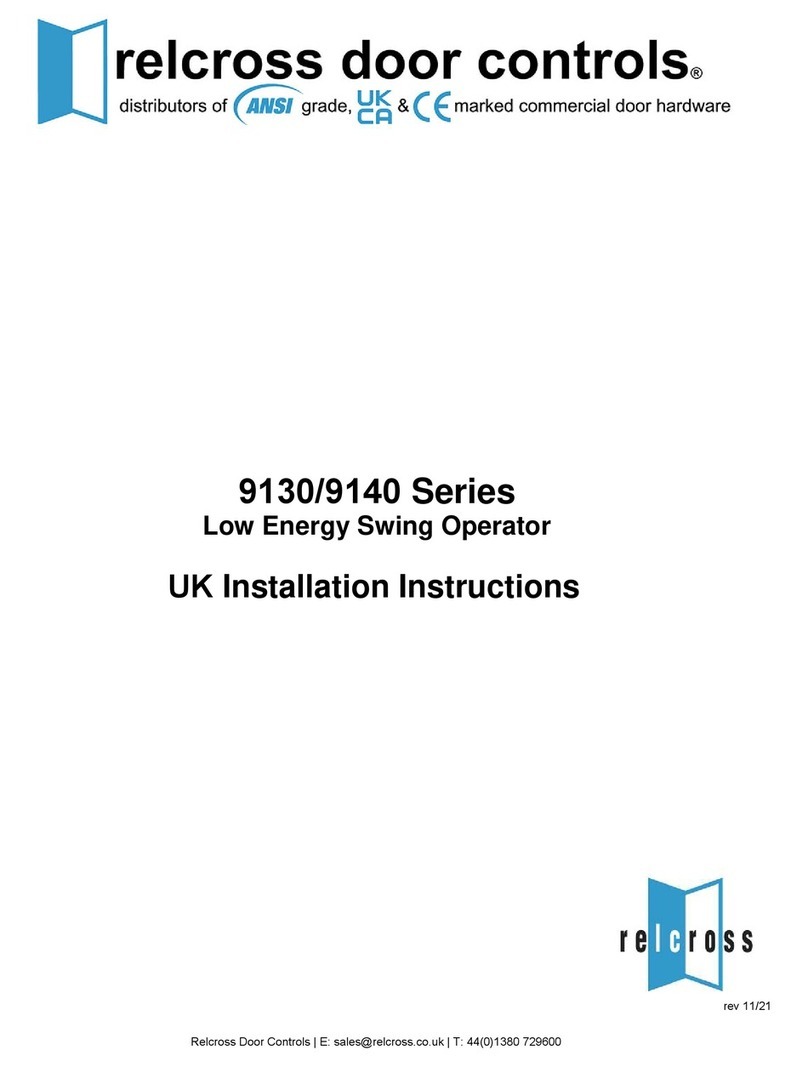OSCO SWG User manual

Oct. 2005, Rev. 20
SWG
INSTALLATIONGUIDE
UL325 COMPLIANCE REQUIRES THE USE OF CONTACT EDGES
OR PHOTOELECTRIC CONTROLS ON ALL AUTOMATIC OR
REMOTELY-CONTROLLED GATE OPERATORS.
OPERATORSPECIALTYCOMPANY,INC.
CASNOVIA, MI 49318 • U.S.A.
®

SWGOPERATORINSTALLATIONGUIDE
-2-
TABLEOFCONTENTS
CAUTION!
DO NOT INSTALL
CONTROLSON
THEOPERATOR
CAUTION!
ONLYQUALIFIED SERVICE
TECHNICIANSSHOULD
WORK ON AN OSCO
SWINGGATE OPERATOR
CAUTION!
DO NOT INSTALL
CONTROLSONOR
NEARTHEGATE
PRE-INSTALLATION INFORMATION
GateOperatorClassifications ......................................................................................................................................3
SafetyInformationand Warnings .................................................................................................................................3
Pre-InstallationInformation ...........................................................................................................................................3
Warranty......................................................................................................................................................................3
INSTALLATION
WiringSpecifications ...................................................................................................................................................4
PostMountingInstructions ..........................................................................................................................................5
String Methodfor Nonstandard Installationof SwingGateOperators ............................................................................6
Articulating -Style Arm Assembly Instructions .............................................................................................................7
Vent Plug Installation ...................................................................................................................................................8
TorqueLimiterAdjustment ...........................................................................................................................................8
ElectricalConnectionandAdjustments........................................................................................................................9
Limit Cam Adjustments ...............................................................................................................................................9
CONTROLBOARD ADJUSTMENTSand ACCESSORYCONNECTIONS
ControlBoardAdjustments ........................................................................................................................................10
TerminalConnection Descriptions .............................................................................................................................. 11
CurrentSensingAdjustments ....................................................................................................................................12
CloseDirectionCurrentSenseAdjustment ................................................................................................................12
OpenDirectionCurrentSense Adjustment.................................................................................................................12
MaximumRunTimerAdjustment ...............................................................................................................................12
AutoCloseTimerAdjustment ....................................................................................................................................12
Master/SlaveConnection ...........................................................................................................................................12
OnboardL.E.D.IndicatorDescriptions .......................................................................................................................13
ImportantNotesforInstallation of Master/Slave Applications......................................................................................14
SurgeProtectorInstructions ......................................................................................................................................14
ControlandAccessoryConnectionIllustrations ....................................................................................................15-18
ILLUSTRATIONS
LoopLayoutIllustration ..............................................................................................................................................19
EdgeLayoutIllustration#1.........................................................................................................................................20
PhotoEyeIllustration.................................................................................................................................................21
TROUBLESHOOTING ...................................................................................................................................................22
PARTS LISTS
HowtoOrderReplacement Parts...............................................................................................................................22
Model SWG Mechanical Parts Exploded View...........................................................................................................23
Model SWG Mechanical Parts List ............................................................................................................................24
Model SWG Single Phase Control Box Exploded View and Parts List .......................................................................25
Model SWG Three Phase Control Box Exploded View and Parts List ........................................................................26
Model SWG Gate Arm Assembly Parts List ..............................................................................................................27
PREVENTATIVEMAINTENANCE ..................................................................................................................................29
GATEOPERATORINSTALLATIONCHECKLIST ..........................................................................................................30

SWGOPERATORINSTALLATIONGUIDE
-3-
Read the following before beginning to install OSCO swing
gate operators:
1. Readtheorange “Safety Instructions”brochureenclosed
with the packet of information. If you do not have one,
pleasecallOSCOat1-800-333-1717torequestone. Read
andfollowallinstructions.
2. All electrical connections to the power supply must be
made by a licensed electrician and must observe all
national and local electrical codes.
3. A separate power-disconnect switch should be located
neartheoperatorso that primarypowercanbe turned off
whennecessary.
4. Install the enclosed warning signs on both sides of the
gate. Each sign must be plainly visible from the side of
the gate on which they are mounted.
5. Never reach between, through or around the fence to
operatethegate.
6. You must install all required safety equipment.
GATEOPERATOR
CLASSIFICATIONS
All gate operators can be divided into one of four different
classifications, depending on their design and usage.
Class I Residential Vehicular Gate Operator
Avehiculargate operatorintendedforuse in ahomeof one to
foursinglefamily dwellings, orgarageorparking area associ-
atedwiththesedwellings.
Class II Commercial / General Access Vehicular Gate
Operator
A vehicular gate operator intended for use in a commercial
location or building such as a multifamily housing unit of five
ormoresinglefamilyunits, hotel, retail store orotherbuilding
servicingthegeneralpublic.
Class III Industrial / Limited Access Vehicular Gate
Operator
A vehicular gate operator intended for use in an industrial
location or building such as a factory or loading dock area or
otherlocationnotintendedtoservicethe general public.
Class IV RestrictedAccess Vehicular Gate Operator
Avehiculargate operatorintendedfor useinaguardedindus-
trial location or building such as an airport security area or
other restricted access locations not servicing the general
public,inwhich unauthorizedaccessis preventedviasupervi-
sion by security personnel.
PRE-INSTALLATION
INFORMATION
Before unpacking, inspect the carton for exterior damage. If
youfinddamage,advisethedeliverycarrierofapotentialclaim.
Inspect your package carefully. You can check your
accessory box parts with the enclosed packing slip for your
convenience.Claimsfor shortageswillbehonored foronly30
days from the date of shipment.
Before installing the operator, read this manual completely
toensureallrequirementsforproper installation are present.
Verify that the voltage to be used matches the voltage of the
operator.
SAFETYINFORMATION
ANDWARNINGS
IMPORTANT!!
Beforeinstallingthegateoperator,make surethegate’sswing
is free and level throughout the entire swing path. If the gate
does not seem to operate properly, it may affect the operator
performance or greatly shorten the life of the unit. The gate
should be designed so that airflow is ample to prevent wind
resistanceanddrag.
The following contact or non-contact obstruction
detection devices have been approved for use
with OSCO slide gate operators as part of a UL325
compliant installation:
ContactEdges:
MillerModels*:MG0-20,MGR-20, MGS-20, and ME-120
Photoeyes:
2520-441 MMTCModelIR-55photoeye,165’with
mountinghardware
2520-031 MMTC Model E3K photoeye, 28’ with
mountinghardware
*for OSCO part numbers, contact a sales representative for details
10-05-20

SWGOPERATORINSTALLATIONGUIDE
-4-
USE COPPER WIRE ONLY! ACCESSORYWIRING
All Models
24VDC
*Over 350 ft. use DC power.
0-2000
14
24VAC
250
350*
14
12
Volts
Maximum
Distance (ft.)
Wire
Gauge
1. Select from the chart at the bottom of this page corresponding to the
model, voltage and horsepower rating of your operator.
2. The distance shown on the chart is measured in feet from the opera-
tor to the power source. DO NOT EXCEED THE MAXIMUM DIS-
TANCE. These calculations have been based on standard 115V and
230V supplies with a 10% drop allowable. If your supply is under the
standard rating, the runs listed may be longer than what your appli-
cation will handle, and you should not run wire too near the upper
end of the chart for the gauge of wire you are using.
3. When large-gauge wire is used, a separate junction box (not sup-
plied) may be needed for the operator power connection.
4. All control devices are now 24VDC, which can be run considerable
distances. 24VAC is available for other devices, such as loop detec-
tors and photo eyes.
5. Wire run calculations are based on the National Electrical Code, Ar-
ticle 430 and have been carefully determined based on motor inrush,
brake solenoids, and operator requirements.
WIRINGSPECIFICATIONS
6. Connect power in accordance with local codes. The green ground
wire must be properly connected.
7. Wire insulation must be suitable to the application.
8. Control wiring must be run in a separate conduit from power wiring.
Running them together may cause interference and faulty signals in
some accessories.
9. Electrical outlets are supplied in all 115VAC models for convenience
with occasional use or low power consumption devices only. If you
choose to run dedicated equipment from these devices, it will de-
crease the distance for maximum run and the charts will no longer be
accurate.
10. A three-wire shielded conductor cable is required to connect master
andslaveoperators.You must use Belden 8760TwistedPair Shielded
Cable (or equivalent) only – OSCO part number 2500-1982, per
foot). See page 10 for details of this connection, as well as dip
switch selection. Note: The SHIELD wire should be connected
in both the master and slave operators.
MODELSWG–SINGLEPHASE
gniriWrewoP
stloV
PH&
ecnatsiDxaM
lauDelgniS
eriW
eguaG
stloV
PH&
ecnatsiDxaM
lauDelgniS
eriW
eguaG
stloV
PH&
ecnats
iDxaM
lauDelgniS
eriW
eguaG
V511
2/1
PH
222
453
665
009
0341
111
771
382
054
517
21
01
8
6
4
V802
2/1
PH
067
0021
4291
0603
4684
083
006
269
0381
2342
21
01
8
6
4
V032
2/1
PH
498
2241
4622
0063
4275
744
117
2311
0081
2682
21
01
8
6
4
V511
4/3
PH
871
282
054
617
0411
98
14
1
522
853
075
21
01
8
6
4
802
4/3
PH
406
859
6251
4242
6583
203
874
367
2121
8291
21
01
8
6
4
V032
4/3
PH
017
8211
6971
2582
8354
553
465
89
8
6241
9622
21
01
8
6
4
V511
PH1
061
452
604
646
6201
08
721
302
323
315
21
01
8
6
4
V802
PH1
445
468
4731
4812
6743
272
234
686
2901
8371
2
1
01
8
6
4
V032
PH1
046
6101
6161
0752
0904
023
805
808
5821
5402
21
01
8
6
4
esahP3:gniriWrewoP
stloV
PH&
ecnatsiDxaM
lauDelgniS
eriW
eguaG
stloV
PH&
ecnatsiDxaM
lauDelgniS
eriW
eguaG
stloV
PH
&
ecnatsiDxaM
lauDelgniS
eriW
eguaG
V802
2/1
PH
2411
6181
0982
175
809
5441
21
01
8
V032
2/1
PH
4431
7312
0043
276
9601
0071
21
01
8
V064
2/1
PH
1483
6016
2179
1291
3503
6584
21
01
8
V802
4/3
PH
029
4641
0332
064
237
5611
21
01
8
V032
4/3
PH
4801
3271
1472
245
2
68
1731
21
01
8
V064
4/3
PH
9723
2125
1928
0461
6062
6414
21
01
8
V802
PH1
417
6311
4081
753
865
209
21
01
8
V032
PH1
048
6331
4212
02
4
866
2601
21
01
8
V064
PH1
9862
4724
8976
5431
7342
9933
21
01
8
MODELSWG–THREEPHASE
12-02-11

SWGOPERATORINSTALLATIONGUIDE
-5-
POSTMOUNTINGINSTRUCTIONSFORMODELSWG
23”SPACEREQUIREDBEHINDOPERATOR
FORARM CLEARANCE WHILEOPENING
IFNONSTANDARDMOUNTING IS NECESSARY,
CONSULT THE FACTORY
Usetwo3 -31/2” diametergalvanizedposts andsecurewithconcrete
footings as shown, length to be determined by local codes, frost line
depth, and soil conditions.
Attach the operator with the U-bolts, side plates and hardware pro-
vided. There are four side plates. The 3/16” side plates go on the in-
sidetopofthe operator,while the two 1/2”sideplatesgoon the inside
bottom(seetheillustrationatright). Theoperatorshould bepositioned
atalevelto allow thearmtobeinstalled at mid-heightonthegate. “H”
dimension can vary depending on gate construction. Make sure the
postsdonotprotrudeabove the operator cabinet.
Assemble the arm components as shown on page 7.
ASEPARATEPEDESTRIANGATEISREQUIREDFOR
ALLPEDESTRIANTRAFFIC.THIS GATEMUSTBEA
MINIMUMDISTANCEOF7FEETFROMTHE
VEHICULARGATEANDGATEOPERATOR
NOTE: Maximum gate opening
angleisapproximately 95degrees,
depending on gate width. If larger
opening angle is required, non-
standard positioning of the opera-
tor and modified articulating arms
will be required. Contact the fac-
tory for pricing and availability.
DOORMUST
FACEAWAY
FROM
DRIVEWAY
SIDEPLATEINSTALLATION
3-05-19

SWGOPERATORINSTALLATIONGUIDE
-6-
STRINGMETHODFORNONSTANDARDINSTALLATIONOFSWINGGATEOPERATORS
Step A: Position the Operator
1. Connect the gate plate assembly onto the gate at the recommended
location for a standard installation (Dimension “W”).
2. Open the gate to its fully-open position.
3. Positiontheoperator parallel tothegate.The distancefromtheoperator
output shaft to the gate plate pivot point is shown at right. The operator
shouldbepositionedthesame distance from the gatehingeasthegate
plate has been; ie: the “W” dimension.
Step B: Measure the Crank Extension and Link Center to Center
Distances
1. Close the gate.
2. Using a piece of tape, attach a string to the top of the operator output
shaft, at its center. Holding the string taut and using another piece of
tape, hold the other end of the string across the hole in the gate plate.
This distance is Dimension 1. Carefully measure this dimension and
writeit down.
3. Openthegate.
4. Pick up the string, while it is still attached at both ends, and pull it taut
againwhilepositioningit directly overthecenterofthe operator shaft, at
Point“B,”andwork yourwaybackalong the stringuntilyoureach Point
“C.”
5. While holding the string taut, measure the distance from Point “B” to
Point “C.”This is the required center to center distance for the crank
extension.
6. Measure the distance from Point “A” to Point “C.”This is the required
center to center distance for the link section.
7. When added together, the distances from Point “A” to Point “B” and
Point “B” to Point “C” should equal the Dimension 1measurement.
DOORMUST
FACEAWAY
FROM
DRIVEWAY
These measurements will be needed when placing an order for special
length crank extensions and links. Also note that the measurements you
have just calculated are center to center only, and are not overall dimen-
sions,whichwouldalso include otherattachmenthardware,such as gate
arm clamps.
It is also possible that both open and closed limit switches may be acti-
vatedateitherendofgatetravel due to the total gate travelrequired,and
theshape of the limit switches and cams. This problem can becorrected
by carefully bending the limit switch arm slightly and readjusting its cam.
PLEASENOTE:Youroperatormaylookdifferentwheninstalled.
Thedrawingsonthis pagearefor general referenceonly.

SWGOPERATORINSTALLATIONGUIDE
-7-
ARTICULATING-STYLEARMASSEMBLYINSTRUCTIONSFORMODELSWG
NOTE:Illustrationsshown on this pageareforright-handapplication.
Forleft-hand,overtravelstop(9) should be ontheoppositesidefromwhat is shown above.
Numbered items in these
drawingsareforinstructional
referenceonly.Foractualpart
numbers,gototheparts lists
in the back of this booklet.
Place the crank extension (2) on the operator crank
(1)asshown.Slide a black spacer(3)into thecrank
and hold it while sliding a 1/2-13 x 1 3/4” hex head
bolt (4) through the extension and crank.Assemble
witha1/2”flat washer and locknut andtighten.Slide
the clevis pin (5) and a 1/2” flat washer through the
crank and the extension. Slide another 1/2” flat
washerovertheendofthepinandlockitwitheither
a disconnect pull pin or with an optional pad lock
through the pin.
Angleiron(notsupplied)(13)shouldbeweldedto the gate
priortothis step.Attachthegateplate(12)to the angle iron
using 3/8 bolts, flat washers, lock washers and hex nuts
(15). Slide a 1/2-13 x 1 1/4” bolt, 1/2” lock washer, 1/2” flat
washer(14),andablackspacer(3) through the gate plate.
Placeanylon washer (8)overtheopening in thegateplate.
Threadthe boltintotheholeinthegateclamp(6) andtighten
carefully. Do not overtighten! Tighten set screw (19) to
further lock hex bolt (14) in place.
Slidethepipe link(16)through thearmassemblyas shown.
Place the 5/16” square bolts in the gate clamps (17) and
tightencarefully. Do not overtighten!
Slidea1/2” lockwasherandflatwasheronto the1/2-13x 21/
2”hexheadbolt(10).Addanylonwasher(8),then slide the
boltthroughthecrankextension(2)andholdinplaceNext,
insert the yellow-plated pivot spacer (11) into the crank ex-
tension,addanylonwasher(8)andplacethe offset spacer
(7)ontopof the nylonwasher.Add anylonwasher(8)to the
top of the offset spacer (7) and add the silver zinc-finish
overtravelstopspacer(18).Slidethe overtravelstopbracket
(9) over the silver zinc-finish spacer and add the last nylon
washer (8) above the bracket. Carefully screw the bolt as-
semblyinto thealuminumgateclamp(6)untilthe lockwasher
has been fully compressed. The overtravel stop and crank
extensionshouldfloatfreely, without binding, when itisfully
assembled. Tighten set screw (19) to further lock hex holt
(10)inplace.
8-04-18

SWGOPERATORINSTALLATIONGUIDE
-8-
TORQUELIMITERADJUSTMENT
MODEL SWG
LOCKING TAB
ADJUSTMENT NUT
VENTPLUGINSTALLATION
GearreducersusedinOSCO gate operators will havesolidplugsinstalledpriorto shipment in order tokeeptheoilinsidefrom
spillingoutduring shipping.Avent plughasbeenprovided toreplacethisplug duringinstallation.This plugwilllooksimilar tothe
ones shown below. Some models may have a vent plug with a breather pin. This pin should be removed after installing the
operator.
OR
Before adjusting the torque limiter, make sure the gate is in
goodworkingcondition.Onepersonshouldbeable to move
thegatebyhand. Becertain the gate moves freely andwith-
out binding throughout its travel.Torque limiters are set light
atthefactory.Theymustbe adjusted duringinstallation,pref-
erablyafterlimitcamshavebeenmanually set (see page 9).
Adjust the torque limiter tight enough to keep it from slipping
duringnormaloperation.
To adjust the torque limiter in model SWG:
1. Bend the locking tabs away from the adjustment nut.
2. To increase the output, turn the adjustment nut clock-
wise one flat, or 1/6 turn, at a time until desired output is
obtained.
To reduce the output, turn the adjustment nut counter-
clockwise one flat, or 1/6 turn, at a time until desired
outputisobtained.
3. Bend the locking tabs up to lock the adjustment nut in
place.

SWGOPERATORINSTALLATIONGUIDE
-9-
ELECTRICALCONNECTIONANDADJUSTMENTS
All OSCO gate operators are supplied with a power disconnect switch to turn on and off the power supply available to the
operator. Incoming power should be brought into the operator and connected to the labeled pigtails in the disconnect box,
following wiringspecifications on page 4.Awiringconnectionsprintcanbefoundontheinsidecoveroftheoperator.
Properthermalprotectionissupplied withtheoperator.Themotorcontainsathermaloverloadprotectortoprotect fromoverheat-
ingthemotordueto overload or high-frequency operation.Thisoverloadwillresetautomatically after the motor coolsdown.
LIMITCAMADJUSTMENTS
The limit cams are not preset at the factory and must be adjusted for the length and opening angle of the gate the operator is
installedon.The limitswitchesareactivated by aseriesof rotating limitcamswhichare attachedtothedrive shaft.Theoperator
hasalsobeen presetintheright handoperationmode.If theinstallationrequiresleft handoperationadip switchmustbeflipped
(seepage10).
With the gate connected tothe gate operator in a mid-travel position,the power disconnect switch turned OFF,andthetorque
limiter set loose enough to slip freely, manually move the gate to its fully open position.
Once the gate is in the fully open position, adjust the limit cam for open direction. Set the LSO-1 limit cam so that it has just
triggered its switch.
Once the open limit cam is set, repeat the above process for the close direction, LSC-1.
Afterfinishingtheinitiallimitcamadjustments,repositionthe gate to approximately the center of travel. At this time, adjust the
torque limiter as explained on page 8. Turn the power disconnect switch ON, stand clear of any moving parts and press the
OPEN button.Observethe gateasitruns throughacomplete cycle inbothdirections, andadjustyourlimitsagain ifnecessary.If
theoperatorstopsduring travel, youmayneedtoadjust the openorclosecurrentsensor adjustment orthemaximumrun timer
(seepage12).
Power supply must be of correct voltage and phase.
Always disconnect power from operator before servicing.
Keep clear of gate during operation.
9-13-02
POWERDISCONNECT BOX
(115VAC VERSION SHOWN)
L1
(WHITE)
L2
(BLACK)
GROUND
(GREEN)
LIMITS and CAMS
MODEL SWG
FROM TOP TO BOTTOM:
LEFTHAND RIGHT HAND
LSC-1 LSO-1
LSO-1 LSC-1
WHENEVER HAND OF OPERATION CHANGES, BOTH LIMIT CAMS WILL
NEEDTOBE ADJUSTED.

SWGOPERATORINSTALLATIONGUIDE
-10-
Auto Close Timer Adjustment: This 270-degree adjustable potentiometer will signal the operator to close automatically,
providednoopen, reversingorobstructionsignals arepresentfrom thefully-openposition.This timerisadjustablefrom 0to124
seconds. This feature is turned on or off using dip switch #1.
Maximum Run Timer Adjustment: This270-degreeadjustablepotentiometerwillsignal the operator to stop running once it
counts down, unless a limit switch is reached or an input is received first. Each time the motor starts, this timer will begin
counting. This timer is adjustable from 15 to 100 seconds. If the timer expires, the unit locks out and the emergency alarm
sounds.
Open Direction Current Sense Adjustment: This multiturn potentiometer is used to calibrate the built-in current sensing
featurefordetectionofobstructionswhile running in the open direction.
Close Direction Current Sense Adjustment: This multiturn potentiometer is used to calibrate the built in current sensing
featurefordetectionofobstructionswhilerunningin the closed direction.
Master/Slave Connection Block: Thisterminalblockisused in conjunction with twooperatorstoconfiguretwo gates to open
andclosetogether.
Dip Switches:
#1 This switch turns the auto close timer off/on.
#2 This switch is used in conjunction with alarms and flashing lights that may be added to the operator. When the switch is
intheON position,thesedeviceswillstartapproximatelytwo seconds prior to the operator starting. In theOFF position,
thedeviceswillonlyworkwhiletheoperatorisrunning.
#3 This switch is used in conjunction with single-button controls and radio receivers. In the ON position, successive inputs
will cause signals in the order of OPEN-STOP-CLOSE-STOP. In the OFF position, inputs will cause an OPEN signal
unless the gate is fully open, in which case it will signal CLOSE.
#4 This switchdeterminesright-hand vs.left-handbehavior.Whenlookingfrom insidetheprotected areatowardthe gate,the
sideofthe drive theoperatorison determinesitshandofoperation. IntheOFF position,the operator issetforright-hand.
#5 When turned ON, this switch will allow a one-second delay for solenoid locks to unlock before the motor starts.
#6 In the ON position, the reverse delay is 1 1/2 seconds. In the OFF position, the reverse delay is 3 seconds.
#7 Not used at this time.
#8 This switch is used to set Master/Slave configuration. Operators which are stand-alone or master units should be set to
OFF, while only slave units should have this switch set to ON.
CONTROLBOARDADJUSTMENTS
NOTE:DONOTFORCE270-DEGREEPOTENTIOMETERS
BEYONDTHEIRNORMALRANGEOFMOTION
ORDAMAGEMAYRESULT!
Control Board
with AC
Motor Board
DIAGNOSTIC
L.E.D.s
TERMINAL STRIP #2
CONNECTOR
TERMINAL STRIP #1
CONNECTOR
LIMIT SWITCH
CONNECTOR
LIMIT SWITCH
L.E.D.s
3-05-19

SWGOPERATORINSTALLATIONGUIDE
-11-
You must follow all required safety precautions and instructions at all times. Review the safety brochure
included with the operator. If any pages are missing or unreadable, contact OSCO at 1-800-333-1717 to request
additional copies.
Never connect a button station within reach of the gate or on the side of the gate operator.
Do not adjust the circuit board current sensing feature too high. It should be adjusted high enough to keep the
gate from falsely triggering the sensing, but no higher than necessary for the gate to operate. Do not defeat the
purpose of this function!
TERMINALCONNECTIONDESCRIPTIONS
TERMINALS FUNCTION DESCRIPTIONOFFUNCTION
24VAC 24VAC Providesfused24VoltACpowerfor accessories.
24VACN Note: DC models will NOT have 24Volt AC power available.
24VDC+ 24VDC Provides fused 24Volt DC power for accessories.
24VDC- COMM.
1 & 4 OPEN Openstheoperator.Severalaccessoriessuch as button stations, keypads,trans-
mitters and card readers can be wired to open.
3 & 4 CLOSE Closes the operator. Use caution when wiring accessories to these terminals.
The gate must be clearly visible from the location of any accessories wired
to close.
4 & 5 SINGLE-BUTTON Performs the single-button function which will alternate between open and close
or open, stop and close - depending on dip switch #3. (See page 10 for details.)
2 & 4 STOP Stops the operator. If no stop button is used, a jumper is required across 2&4.
4 & 6 REVERSE Thisfunctionwillcause a reversal when the gate is traveling closed and will travel
back to the fully open position. Loop detectors are often wired for reverse.
4 & 50 OPEN This function works only while the operator is opening. Any signal to this function
will cause the gate to stop, reverse a short distance, and then stop again. At this
time the auto close timer is disabled, and a renewed input will be required to start
the gate again. Should the gate be restarted and the signal occur again prior to
reaching a limit, the gate will stop again, and this time will sound the emergency
alarm and lock out.
4 & 51 CLOSE ThisfunctionworksexactlyliketheOPEN OBSTRUCTION, except that it will only
work in the closing direction.
4 & 11 SHADOW/HOLD Thisfunctionwillkeepthegatein its fully open position while the signalispresent.
This is typically used with a loop and loop detector to keep a large swing gate
open while vehicular traffic is passing through.
24VDC+&60 RUN/PRE-START A24VoltDC devicesuchasastrobe light or alarmcanbewiredto these terminals.
Depending on dip switch #2, these devices will either begin three seconds before
the operator starts, or only while the motor is running. (See page 10 for details.)
OBSTRUCTION
OBSTRUCTION
3-05-19

SWGOPERATORINSTALLATIONGUIDE
-12-
CURRENTSENSINGADJUSTMENTS
Because gates vary in construction and may have different force requirements in the open and close directions to move, the
OSCO control board has separate Multi-turn potentiometers for adjusting in both directions independently. The adjustment
should be set light enough to maintain minimal force (40 lbs.) should an obstruction occur, but high enough to keep the gate
movingundernormal conditions withoutinterruption.
Priortoadjustingthe operator current sensingfunctions,makesurethe gate moves freelyinbothdirections.A badly aligned or
poorlymaintainedgatemaycausefalse triggeringofthecurrent sensor.Refer to page10when followingtheinstructionsbelow.
Afactory adjustment tool has been supplied to make these adjustments easier.This tool has been taped to the control box for
yourconvenience. CLOSEDIRECTIONCURRENTSENSEADJUSTMENT
When the gate operator leaves the factory, it has been preset for a relatively light gate function and will require additional
adjustment.Beginby starting the gate going closed. If the operator stops and reverses, turn the close direction potentiometer
(seepage10) one turn higher,presstheSTOP button, and tryagain.Repeatthisprocessuntilthegate no longer causes false
trippingofthecurrent sensor.Notethat each timethegateoperatorreverses, the STOP buttonmust be pressed.Next,turnthe
close direction potentiometer lower slowly while the operator is running the gate closed until the gate operator stops and
reverses again. From this point, turn the close direction potentiometer higher by 1 1/2 turns for all 115 VoltAC and 24 Volt DC
operators,andby3/4 of a turn higherforall230VoltACoperators.Additionalfineadjustmentby1/4 turns may benecessaryto
eliminatefalsetriggering.
OPENDIRECTIONCURRENTSENSEADJUSTMENT
Repeatthesameprocess with the opendirectionpotentiometerwhilerunning the gate intheopendirection.Oncethis is done,
run the gate through several complete cycles and make sure the gate does not false trip in either direction.
MAXIMUMRUNTIMERADJUSTMENT
Thisadjustablepotentiometersets the maximum lengthoftimethemotor will run beforeshuttingdown.Itshould be configured
for the time it takes to run the gate fully open or closed, plus an additional 15 seconds. See page 10 for details.
AUTOCLOSETIMERADJUSTMENT
Thisadjustablepotentiometer setsthelengthof timewhichelapsesbefore thegateoperatorautomatically closesthegate,from
thefullyopenposition,provided noopen,reversing, orobstructionsignals arepresent.Thisfeaturecanbeturnedon oroffvia dip
switch selection. See page 10 for details. Do not use the auto close timer without an appropriate reversing device
installed! MASTER/SLAVECONNECTION
Athree-wire shielded conductor cable is required to connect master and slave operators.You must use Belden 8760 Twisted
Pair Shielded Cable(or equivalent) only –OSCOpartnumber2500-1982, per foot).Seepage10 for details ofthisconnection,
as well as dip switch selection. Note: The SHIELD wire should be connected in both the master and slave operators. In addition, you
must run power to both the master and slave operators.
Multi-turn Potentiometer
Remember it is important not to set the adjustment
too high! Doing so will defeat the purpose of the cur-
rent sensing as an obstruction detecting feature.
3-05-19

SWGOPERATORINSTALLATIONGUIDE
-13-
ONBOARDL.E.D.INDICATORDESCRIPTIONS
Control Board L.E.D. Indicators:
OPEN This indicator is lit when an open signal is present. This signal can come from such devices as button
stations, radio receivers, keypads and telephone entry systems.
CLOSE This indicator is lit when a closed signal is present. This signal typically comes from three-button stations.
STOP This indicator is lit when there is a break in the stop circuit. Make sure there is a stop button wired in and
workingproperly.
SINGLE This indicator is lit when a signal from a single-button station or radio receiver is present.
CLOSEOBST This indicator islitwhenaclose obstruction signalispresent. Thissignalcancome from edgesandphoto
eyes which have been wired to the close obstruction inputs.
OPENOBST This indicator is lit when an open obstruction signal is present. This signal can come from edges and
photoeyeswhichhavebeenwiredtotheopenobstruction inputs.
SAFETYLOOP This indicator is lit when a reversing signal is present. This signal is generated by a loop detector wired to
the safety loop terminals.
SHADOWLOOP Thisindicatorislitwhenashadow/holdopensignalispresent.This signal is generated by a loop detector
wiredtotheshadowloopterminals.
Thisindicatoris lit whentheopen#1 limit switchisactivatedon a right-handoperator,ortheclose #1 switch
on a left-hand. If this indicator is lit and the gate is not in its full open/closed position, the limit may need
adjusting or the limit switch may need replacing.
Thisindicatoris lit whentheopen#2 limit switchisactivatedon a right-handoperator,ortheclose #2 switch
onaleft-hand.
Thisindicator is lit when the close #1 limit switch is activated on aright-handoperator, or the open #1 ona
left-hand. If this indicator is lit and the gate is not in its full open/closed position, the limit may need
adjusting or the limit switch may need replacing.
Thisindicatoris lit whentheclose#2 limit switchisactivatedon a right-handoperator,ortheopen #2 switch
onaleft-hand.
Motor Board L.E.D. Indicators:
NONLABELED One ofthesetwoindicatorswillbelitwhenthemotor is running the gate open, and the otherislitwhenthe
motor is running the gate closed.
BRAKEREL. This indicator is lit when the brake is NOT applied.
LSO-1
LSO-2
LSC-1
LSC-2
LSC-1
LSC-2
LSO-1
LSO-2
LH RH

SWGOPERATORINSTALLATIONGUIDE
-14-
IMPORTANTNOTESFOR
INSTALLATIONOFMASTER/SLAVEAPPLICATIONS
When setting up Master/Slave gate operators, it is best to make adjustments and run each operator individually. To do this,
simply:
a. SetDipSwitch#4 to proper handofoperation(right-handor left-hand)
b. Set Dip Switch #8 as Master (off)
Runeachoperatormakingcurrentsensingadjustmentsasnecessary, as indicated on the Control BoardAdjustmentspageof
this installation guide. When both operators have been adjusted, turn power off, then turn on Dip Switch #8 in the operator
chosenastheSlave.
Thetimertocloseandradio/singlebuttonbehaviorare set in the Master operator.
Thefollowingselectionsare set individually:
CurrentSensing
MaximumRunTimer
One-SecondLockRelease
Three-SecondPre-StartWarning
Right/Left-HandSelections
8-03-14
SURGEPROTECTORINSTRUCTIONS
The optional surge protector should be connected
to any inputs that have an accessory connected to
it. This includes the 3-button station, so it must be
connected to 1, 2A and 3 in all cases. The green
wire connected to ground, which is electrically the
same as terminal 4. The red wires connect to
terminals 2A and 24VDC+. This will cause the
2 amp fuse to blow if this section of the module
becomes shorted. With any of the other inputs
connectedtothesurgeprotector,iftheirprotection
linebecomesshorted due toasurgeover therating
of the module, the corresponding LED on the main
board will remain lit, causing a constant signal to
the controller. If this is found, please replace the
entiresurge protector with a new unit.
Do not simply unhook the shorted wire, as this
removestheprotection fromthecircuit thatwas
saved by the protector in the first place!

SWGOPERATORINSTALLATIONGUIDE
-15-
CONTROLandACCESSORYCONNECTIONILLUSTRATIONS

SWGOPERATORINSTALLATIONGUIDE
-16-
CONTROLandACCESSORYCONNECTIONILLUSTRATIONS

SWGOPERATORINSTALLATIONGUIDE
-17-
OSCOCONTROLandACCESSORYCONNECTIONILLUSTRATIONS

SWGOPERATORINSTALLATIONGUIDE
-18-
CONTROLandACCESSORYCONNECTIONILLUSTRATIONS
24V
24V

SWGOPERATORINSTALLATIONGUIDE
-19-
LOOPLAYOUTILLUSTRATION
RefertoConnectionDescriptionsonpage11 and LoopAccessoryConnectionsonpage18 for additional details.

SWGOPERATORINSTALLATIONGUIDE
-20-
EDGELAYOUTILLUSTRATION
RefertoConnectionDescriptionsonpage11andContactEdge Connections on page17foradditionaldetails.
Table of contents
Other OSCO Gate Opener manuals
Popular Gate Opener manuals by other brands
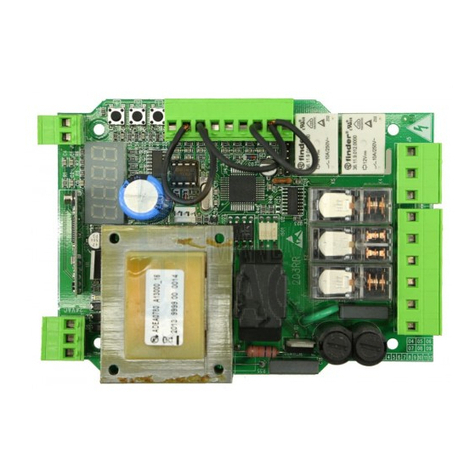
Dea
Dea 203RR Instructions and warnings
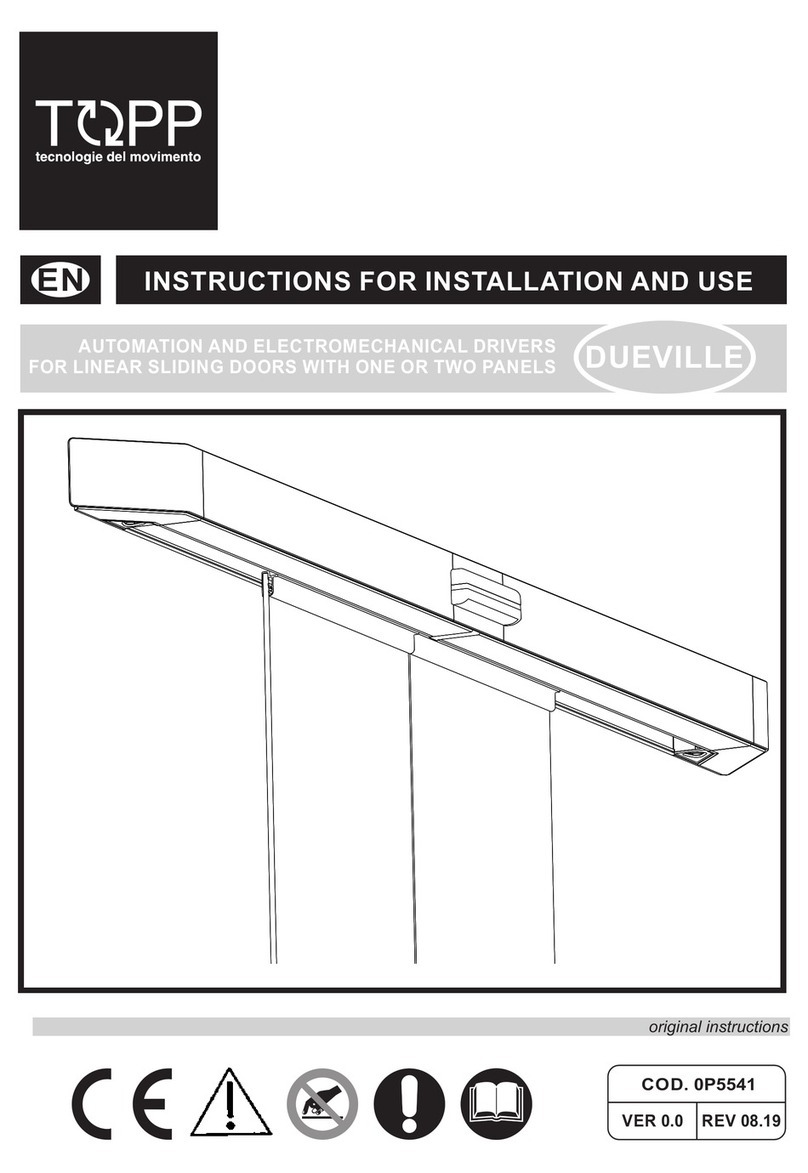
TOPP
TOPP DUEVILLE Instructions for installation and use
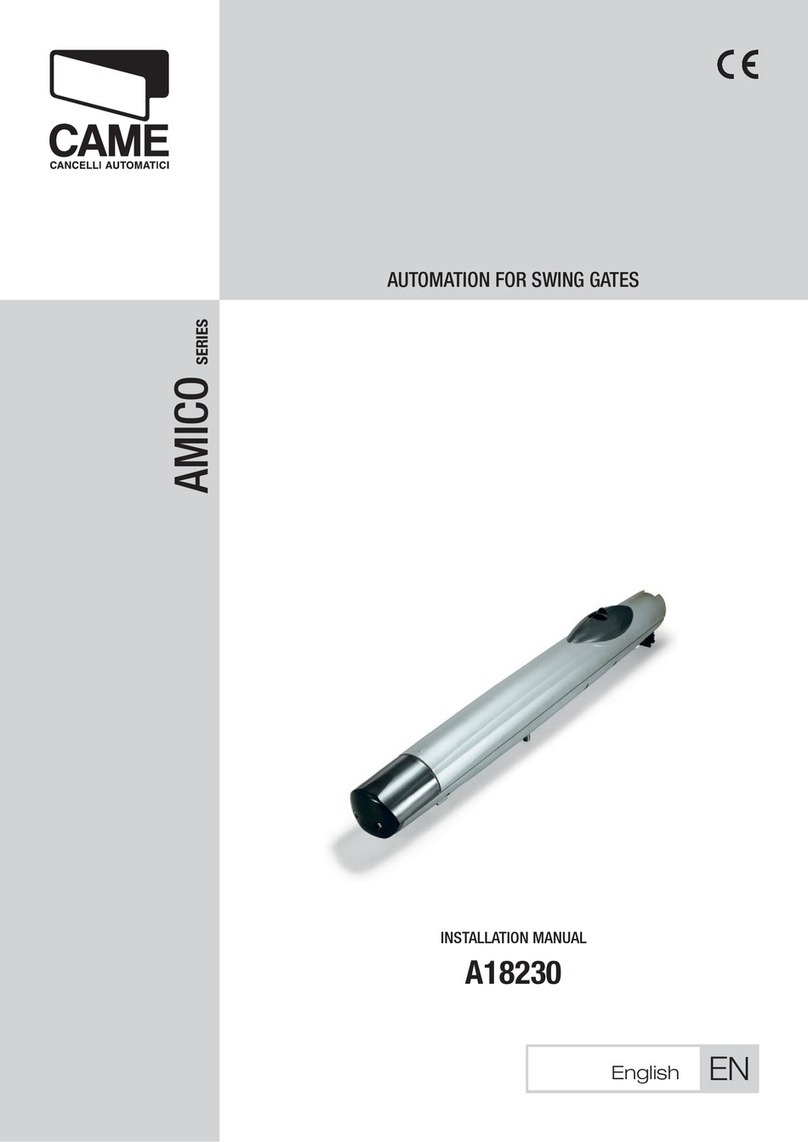
CAME
CAME AMICO Series installation manual
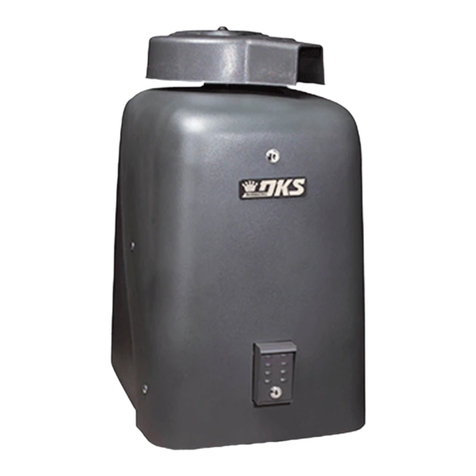
DKS
DKS 6524-081 Installation and owner's guide
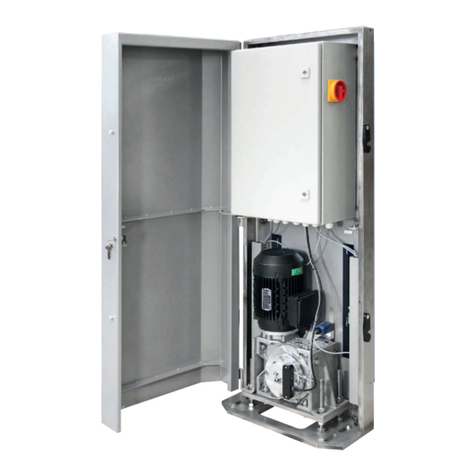
tousek
tousek TPS 60 PRO m6 Mounting and installation manual

Norton
Norton 5700 LEO series Installation and instruction manual
